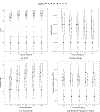Learning to Identify Severe Maternal Morbidity from Electronic Health Records
- PMID: 31437902
- PMCID: PMC7337420
- DOI: 10.3233/SHTI190200
Learning to Identify Severe Maternal Morbidity from Electronic Health Records
Abstract
Severe maternal morbidity (SMM) is broadly defined as significant complications in pregnancy that have an adverse effect on women's health. Identifying women who experience SMM and reviewing their obstetric care can assist healthcare organizations in recognizing risk factors and best practices for management. Various definitions of SMM have been posited, but there is no consensus. Existing definitions are further limited in that they 1) are often rooted in existing clinical knowledge (which is problematic as many risk factors remain unknown), leading to poor positive predictive performance (PPV), and 2) have limited scalability as they often require substantial chart review. Thus, in this paper, a machine learning framework was introduced to automatically identify SMM and relevant risk factors from electronic health records (EHRs). We evaluated this framework with EHR data from 45,858 deliveries at a large academic medical center. The framework outperformed a state-of-the-art model from the U.S. Centers for Disease Control and Prevention (AUC of 0.94 vs. 0.80). Specially, it improved upon PPV by 59% (CDC: 0.22 vs. our model: 0.35). In the process, we revealed several novel SMM indicators, including disorders of fluid or electrolytes, systemic inflammatory response syndrome, and acidosis.
Keywords: Electronic health records; machine learning; severe maternal morbidity.
Figures
References
-
- Centers for Disease Control and Prevention, Severe maternal morbidity in the United States at http://www.cdc.gov/reproductivehealth/MaternalInfantHealth/SevereMaterna... accessed on Nov. 20, 2018.
-
- Joseph KS, Liu S, Rouleau J, Kirby RS, Kramer MS, Sauve R, Fraser WD, Young DC, and Liston RM, Severe maternal morbidity in Canada, 2003 to 2007: surveillance using routine hospitalization data and ICD-10CA codes, J Obstet Gynaecol Can 32 (2010), 837–846. - PubMed
-
- Callaghan WM, Creanga AA, and Kuklina EV, Severe maternal morbidity among delivery and postpartum hospitalizations in the United States, Obstet Gynecol 120 (2012), 1029–1036. - PubMed
MeSH terms
Grants and funding
LinkOut - more resources
Full Text Sources
Medical




